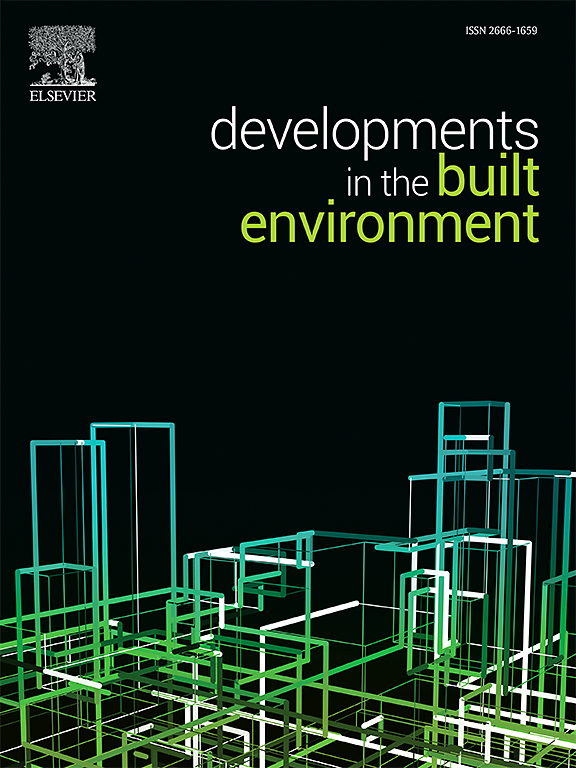Behavioral analysis of steel I-beams under repeated dynamic loads: Impact of various impactor head types
IF 6.2
2区 工程技术
Q1 CONSTRUCTION & BUILDING TECHNOLOGY
引用次数: 0
Abstract
The dynamic loadings to which the structural element is repeatedly exposed cause more damage due to the fatigue effect. In this article, the damage cases formed under the effect of the impact load acting on the weak axis of I-section steel beams under repeated impact loads are investigated and the effect of the geometric shape of the falling weight on the element behavior is evaluated by experimental and numerical methods. A 2000 mm long IPE160 section simply supported beam is subjected to impact load in the weak axis direction. The 100 kg impact load is applied from a height of 2200 mm with a hammer head having three different geometric shapes (rectangular, circular and triangular). Three-dimensional finite element models of the 6 experimental studies were analyzed using Abaqus Explicit software. In order to determine the effect of the geometric shape of the falling weight on the beam behavior under the effect of repeated load; five parameters such as displacement, acceleration, support reaction, stress distribution and plastic strain were investigated. The displacement, acceleration and support reaction formed in the beams were numerically investigated by means of finite element models and compared with the experimental results. The results obtained showed that the maximum deflection and acceleration occurred in the beams hit by the triangle-headed impact crusher. In addition, the largest plastic deformation and stress distribution were observed in the tests performed using triangle-headed impact crushers. In the series I (rectangular), II (circular), III (triangular) test series, the displacement value increased by 44%, 79% and 100%, respectively, compared to the first impact. It is seen that the 2nd degree effects play an important role in the increase of the damage level in the second impacts. It was determined that the maximum reaction force tended to increase from Series I to Series III. This shows that reducing the contact area of the falling weight significantly increases the reaction forces.
重复动荷载作用下工字钢的性能分析:不同冲击头类型的冲击
结构单元反复承受动载荷时,由于疲劳效应造成的损伤更大。本文研究了重复冲击荷载作用下工字型钢梁弱轴受到冲击载荷作用而形成的损伤情况,并通过实验和数值方法评价了落重几何形状对构件性能的影响。研究了一根2000 mm长的IPE160截面简支梁在弱轴方向上的冲击载荷。100公斤的冲击载荷从2200毫米的高度施加,锤头有三种不同的几何形状(矩形,圆形和三角形)。采用Abaqus Explicit软件对6项实验研究的三维有限元模型进行分析。为了确定落重几何形状对重复荷载作用下梁性能的影响;研究了位移、加速度、支承反力、应力分布和塑性应变等5个参数。采用有限元模型对梁内形成的位移、加速度和支承反力进行了数值模拟,并与试验结果进行了比较。结果表明,受三角头冲击破碎机冲击的梁挠度和加速度最大。此外,在使用三角头冲击破碎机进行的试验中,观察到最大的塑性变形和应力分布。在I系列(矩形)、II系列(圆形)、III系列(三角形)试验中,与第一次冲击相比,位移值分别增加44%、79%和100%。可见,二次效应对二次冲击中损伤程度的增加起着重要的作用。结果表明,从系列1到系列3,最大反作用力有增大的趋势。这表明减小下落物体的接触面积会显著增加反作用力。
本文章由计算机程序翻译,如有差异,请以英文原文为准。
求助全文
约1分钟内获得全文
求助全文
来源期刊

Developments in the Built Environment
Multiple-
CiteScore
7.40
自引率
1.20%
发文量
31
审稿时长
22 days
期刊介绍:
Developments in the Built Environment (DIBE) is a recently established peer-reviewed gold open access journal, ensuring that all accepted articles are permanently and freely accessible. Focused on civil engineering and the built environment, DIBE publishes original papers and short communications. Encompassing topics such as construction materials and building sustainability, the journal adopts a holistic approach with the aim of benefiting the community.
 求助内容:
求助内容: 应助结果提醒方式:
应助结果提醒方式:


